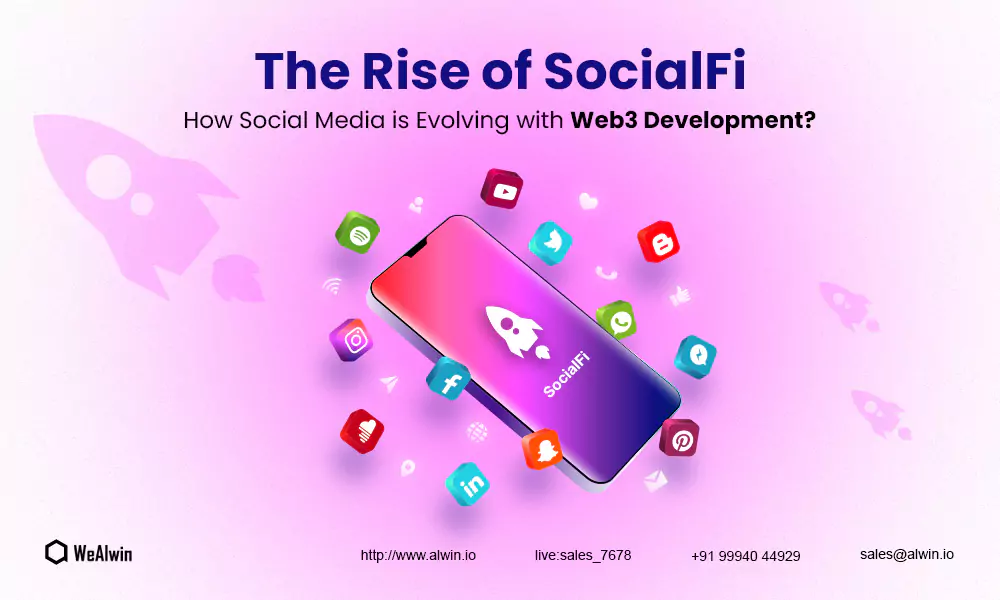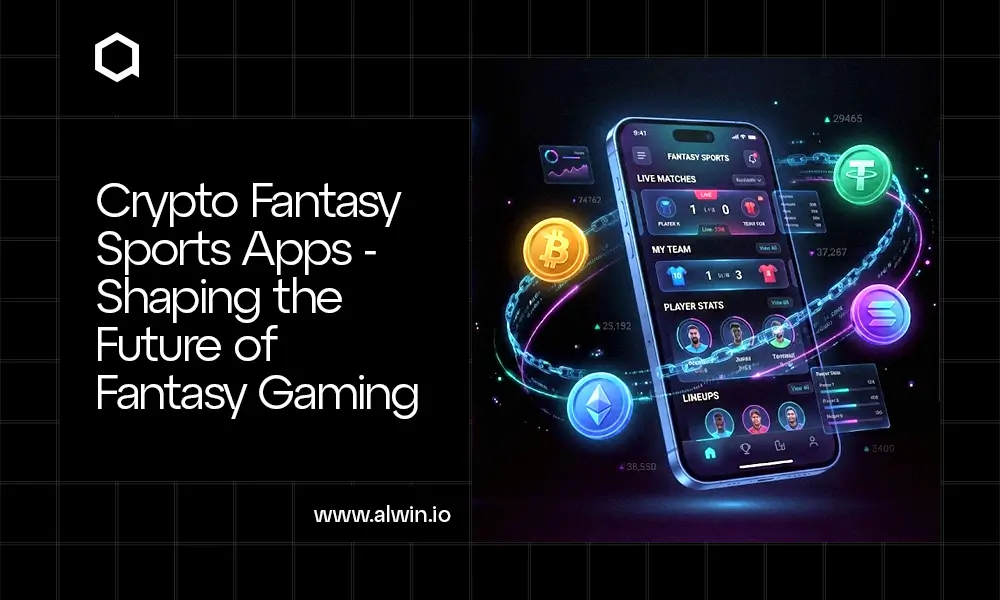In today's digital revolution, Social media plays an integral role in everyone's day to day life, which helps to connect with our friends, family, and the world of new communities. But have you ever thought about how social media is developing with the advent of the development of the next generation of the internet.
How are decentralized blockchain-based social media networks reshaping our online interactions and user privacy?
Learn about the rise of SocialFi - the integration of social media and Web3 - and understand its powerful implications for the future of social media.
What exactly is SocialFi, and why is it significant and How does Web3 Development fit into this major change?
These are the questions that will be itching your mind don’t worry, we'll unravel them by getting into the journey of understanding the transformative power of SocialFi.
Are you ready to dive into the world of Web3-enabled platforms and discover how social media is being revolutionized?
This article will provide you with valuable insights into the revolutionary landscape of social media.
Let's get started and explore from the basics!
To grasp the rise of SocialFi, it is crucial to grasp the fundamentals of Web3 development. Web3 relates to the next generation of the internet, where decentralized technologies and protocols, such as blockchain, enable peer-to-peer interactions without relying on intermediaries. This technological advancement brings about increased transparency, security, and user control, ultimately redefining the way we interact and engage online.

Traditional Social Media and Its Limitations
Traditional social media platforms, like Facebook, Twitter, and Instagram, have revolutionized communication and connectivity. They provide features such as user profiles, content sharing, and network building.
However, their underlying architecture is centralized, meaning the platforms themselves control data storage, content moderation, and decision-making. The centralized nature of traditional social media poses several challenges. User privacy is often compromised, as personal data is collected, stored, and monetized by the platforms.
Moreover, content creators face limited control over their work, and their revenue generation primarily depends on platform algorithms and advertising models.
Additionally, the lack of transparency in content curation and decision-making can lead to biased information dissemination and reduced trust among users.
Understanding Web3 Development
Web3 development leverages technologies like blockchain, distributed storage, smart contracts, and peer-to-peer networks to create trustless and censorship-resistant applications. Blockchain, in particular, serves as a distributed ledger, recording transactions and interactions in an immutable and transparent manner.
Web3 development offers numerous benefits over traditional systems. It ensures enhanced security and privacy by removing centralized intermediaries and placing control in the hands of users.
Transparency and immutability are achieved through non-centralized governance and consensus mechanisms. Web3 enables the creation of token economies, allowing users and content creators to monetize their contributions directly.

The Intersection of Social Media and Web3
SocialFi represents the convergence of social media and Web3 development, promising a new era of decentralized social networks. It aims to empower users by offering increased privacy, data ownership, and control over their online experiences. SocialFi platforms leverage Web3 technologies to build trust, fairness, and inclusivity in their ecosystems.
How Web3 Technologies Are Transforming Social Media?
Web3 technologies are revolutionizing social media in multiple ways. Decentralized networks facilitate transparent and community-driven decision-making, ensuring that users have a say in the platform's governance. Smart contracts and blockchain-based verification mechanisms enhance trust and security while addressing issues such as fake accounts and manipulated content.
Moreover, content discovery and curation are becoming increasingly user-centric and community-driven, prioritizing quality and relevance.
SocialFi offers a range of benefits for both users and content creators. Users enjoy improved privacy protection, data ownership, and greater control over their online identities. On the other hand, content creators benefit from fair compensation models, direct monetization opportunities through token economies, and the ability to safeguard their intellectual property.
The transition to SocialFi empowers individuals to play an active role in shaping the social media landscape.
Decentralization and Governance in SocialFi
Decentralized governance lies at the core of SocialFi platforms. Through voting mechanisms and community consensus, users actively participate in decision-making processes, such as platform rules, content moderation policies, and platform upgrades. This democratic approach ensures that no central authority has absolute control, which encourages a more inclusive and transparent environment.
The Role of Blockchain Technology in Decentralization
Blockchain technology plays an important role in achieving decentralization in SocialFi platforms. It provides a hard to change and auditable record of engagements, ensuring transparency and trust in governance processes.
Smart contracts, executed on the blockchain, enable the automation of rules and agreements, eliminating the need for intermediaries and reducing the potential for censorship or manipulation.
Empowering Users Through Participatory Decision-Making
In SocialFi, users become active participants in platform governance. They have the power to propose and vote on platform changes, community guidelines, and content moderation policies.
This participatory decision-making ensures fair representation and encourages a sense of ownership and collective responsibility among users, building a stronger and more engaged community.
Enhanced Privacy and Data Ownership in SocialFi
Privacy is a growing concern in traditional social media platforms where users face challenges in controlling the use of their personal data. This data is often collected and shared with third parties for targeted advertising and profiling, eroding trust and compromising user privacy.
However, Web3 development provides solutions to address these concerns. SocialFi platforms leverage decentralized storage and encryption techniques, giving users greater control over their personal data.

Users can selectively share information to preserve their privacy, and blockchain technology ensures transparent tracking of data usage. These platforms prioritize user authority and transparency in data ownership, allowing users to retain ownership of their data and revoke access when needed.
Web3 platforms leverage cryptographic techniques to authenticate and verify users, minimizing the risk of impersonation or unauthorized access.
Consult with our business experts to Build your own Decentralized Social Media app like Instagram! Chat with us on WhatsApp
Content Creation and Curation in SocialFi
SocialFi platforms redefine content creation by providing a more empowering environment for creators. Through decentralized networks, creators have direct ownership and control over their work, eliminating the need for intermediaries. Smart contracts enable transparent and automated revenue-sharing models, ensuring fair compensation for creators' contributions.
In SocialFi, content curation is driven by the community rather than centralized algorithms.
Users collectively determine the relevance and quality of content through reputation systems, where engagement and user feedback play a major role. This approach encourages a diverse and inclusive ecosystem where lesser-known creators have the opportunity to gain visibility based on merit, rather than relying solely on popularity metrics.
Non-Fungible Tokens (NFTs) have gained significant traction in the SocialFi landscape. NFTs allow creators to tokenize and authenticate their digital assets, such as artworks, collectibles, and music. By leveraging NFTs, creators can establish verifiable ownership, provenance, and scarcity, opening up new avenues for monetization and fostering a vibrant marketplace for digital creations.
Token Economies and Monetization in SocialFi
Token economies lie at the heart of SocialFi platforms, introducing novel monetization opportunities. By tokenizing social media platforms, users and content creators can earn tokens as rewards for their contributions. These tokens can be exchanged, staked, or used within the platform ecosystem, creating a self-sustaining economy where value flows directly to the participants.
Micropayments and Monetization Opportunities for Creators
Web3 development enables micropayments, allowing users to contribute small amounts directly to their favorite content creators. This facilitates a more direct and personalized way of supporting creators, breaking away from traditional advertising-centric revenue models. Micropayments also enable a deeper connection between creators and their audience, leading to more sustainable income streams.
Benefits of Token Economies for Users
Token economies offer several benefits to users in the SocialFi world. Users can earn tokens through their activities, such as creating and curating content, engaging with the community, or participating in platform governance. These tokens can be used to unlock premium features, access exclusive content, or even participate in platform-wide decision-making.
Token economies incentivize active participation and reward users for their contributions, creating a mutually beneficial relationship between users and platforms.
The Future of SocialFi
The rise of SocialFi has the potential to disrupt traditional social media platforms. As users become more aware of the benefits offered by decentralization, data ownership, and participatory governance, they may gravitate toward SocialFi platforms that prioritize these principles.
This could result in a significant shift in the landscape, with traditional platforms needing to adapt or risk losing their user base.
Integration of SocialFi with Emerging Technologies
SocialFi is not limited to just social media. Its principles and technologies can integrate with other emerging technologies, such as virtual reality (VR), augmented reality (AR), and the Internet of Things (IoT). This convergence has the potential to create immersive and interconnected experiences, further blurring the boundaries between the physical and digital worlds.
Looking ahead, the future of social media is likely to be decentralized and user-centric. SocialFi platforms, built on Web3 technologies, offer the promise of increased user control, privacy, and fair compensation for creators.
As the adoption of SocialFi grows, we can imagine a social media landscape where users have a direct say in platform governance, where data ownership is the norm, and where content creation and curation are driven by communities rather than algorithms.
Final Thoughts
The rise of SocialFi has transformed the social media landscape by incorporating Web3 Development Services, decentralization, user privacy, and token economies. It addresses the limitations of traditional social media, offering enhanced privacy, data ownership, and fair compensation for content creators.
Despite challenges like scalability and regulation, the potential benefits of SocialFi in terms of user empowerment, privacy, and content monetization make it an exciting avenue for the future of social media.
Join us in evergrowing this movement and shaping the user-centric social media landscape of tomorrow.



